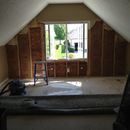How can I stop the mold recurring in my wall?
I have a bonus room over my garage with a double window at the gable end. The outside of the wall is brick faced, wrapped in Tyvek over OSB. The inside has fiberglass insulation, and drywall. The house is 12 years old, located in the Midwest.
A few years ago, I smelled mold coming from this wall that was noticeable through the the house. I removed the drywall and insulation from the wall. The only evidence of mold was a light gray dusty stuff on the inside of the OSB board. There were no leaks around the window, however I repealed it anyway. I cleaned all the mold off, and sealed it with shellac. New fiberglass insulation, and drywall. That was 2 years ago. Now I smell mold again. I’m gearing up to tear off my drywall again at least to get rid of the odor. How can I fix this permanently? Im thinking of spray foaming the wall. I have had a home inspector look at this and I can’t get a fix.
GBA Detail Library
A collection of one thousand construction details organized by climate and house part










Replies
Carr,
I'm not sure what you mean when you wrote, "There were no leaks around the window, however I repealed it anyway." You probably meant "resealed" -- but that still doesn't really tell us what you did.
Were there any signs of water entry near the windows?
One important clue is which direction this wall faces. Does it get direct sunlight? If so, the phenomenon you are observing could be related to inward solar vapor drive. If this wall faces north, then inward solar vapor drive is not the cause of the problem.
Inward solar vapor drive could lead to mold on the OSB, but only if the OSB is cold. That could happen if (a) this room is air conditioned, and (b) the fiberglass insulation was poorly installed and ineffective.
There are a lot of unknowns here, and a good diagnosis would require a site visit. It would really be helpful to determine the source of the moisture.
One final point: Are you sure that there is mold here? Most mold shows up as a black stain -- not "light gray dusty stuff."
When I removed the drywall and insulation, I saw no evidence of water leaks or water stains anywhere. For insurance, I recaulked the window. I also investigated any way cold air from the garage below could be getting in, none found. I believe this to be mold or mildew caused by condensation on the cold OSB surface during the winter. This wall faces north- north east.
I'm not sure how the fiberglass insulation could not be installed correctly. It failed with the builders installation, and it failed again with mine. I am considering spray foam next. Also, the room gets warm, so I have a portable AC in it. I have to think this would reduce humidity, but it's only on in the warm seasons. It may be mildew, and not mold. Any ideas?
One more thing...
I took a core sample of the OSB through to the brick in the area that I think was moldy.. The brick facing leaves barely 1/4" space between it and the tyvac and is filled with mortar "snot". I thought the requirement was 1" for air circulation.
Carr,
If your garage is humid, and there are air leaks at the base of the framed gable wall of the bonus room, it's possible that the humidity form the garage is accumulating on the cold OSB sheathing during the winter.
Regardless of whether the moisture is accumulating during the winter or the summer, spray foam is likely to fix it. Just make sure that there aren't any signs of rain entry or flashing problems.
When the wall was opened up, I sealed the studs and base with silicon caulk. There is no way moisture is coming from the garage in my mind. The spray foam acknowledgement is my best solution. I just want to make sure I'm not creating a new problem, as it would be difficult to remove.
Carr,
Which direction does this wall face -- north, east, south, or west?
It faces north by north east. It gets morning sun in the summer. Not much in winter.
Carr,
Inward solar vapor drive is probably not a factor. So the source of the moisture is still somewhat mysterious.
If I were you, I would install a hygrometer in the bonus room to measure the indoor relative humidity. The more information you have, the better.
This is a ranch style house with a bonus room above the garage. I was wondering if the heat from the hosuse was accumulating there and taking the moisture with it. I am also in the process of encapsulating the crawl space which is the size of the house. I just put a very expensive dehumidifier in the crawl, but the complete the encapsulation is going to take some time. It's quite an undertaking. I will put a hydrometer in the room. Do you recommend holding off on the spray foam? I would still like to tear out the wall and get rid of the odor.
House